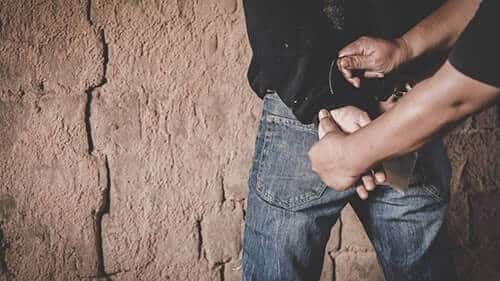
Are you the victim of police abuse, or did you lose a loved one through a wrongful death caused by law enforcement? The personal injury attorneys at Rosenfeld Injury Lawyers, LLC can ensure your family receives the financial compensation they deserve for damages.
Contact our police brutality lawyers at (888) 424-5757 (toll-free phone call) or through the contact form today to schedule a free consultation. All information you share with our law office concerning police abuse remains confidential through an attorney-client relationship.
Many police officers nationwide put their lives on the line to protect the public. However, officers are never above the law, and being issued a gun and badge does not give them the authority to violate others’ constitutional rights.
In 1871, the U.S. Congress passed the Civil Rights Act, 42 U.S.C. § 1983, stating that any individual under state law depriving another of their “rights, privileges, or immunities secured by the Constitution” can face civil lawsuits. The law allows any individual to sue the police officer or any government official for violating their constitutional rights but does not protect victims under state law.
Police Abuse of Power Statistics in the United States
The U.N. Basic Principles of the Use of Force and Firearms involving law enforcement officials serve as the primary international analysis instrument dealing with police use. The United States must abide by the strict international standards and laws that govern when and how law enforcement agencies can use any force, especially lethal force.
In recent years, the trend of people killed by police in America has increased significantly. Released data for 2020 revealed police shot and killed 1021 people nationwide. Other statistics involving police use of force include:
- In 2020, the police killed 457 white people and 241 blacks out of the total of 1021 people killed by police officers that year
- The Bureau of Justice Statistics reveals that African-Americans in the United States are 3.5 times more likely than whites to be killed by officers when the victim was not attacking or did not have a weapon
- Police violence statistics reveal that officers kill a black person about every 40 hours on average in the United States
- Nearly all police brutality and abuse complaints are handled internally by their police departments
- For decades, the rate of fatal police shooting cases involving black Americans has remained higher than any other ethnic group at a rate of 36 fatal shootings per million population
- Law enforcement agency’s use of force is notably higher in minority communities where officers kill unarmed black men and youth
- The National Violent Death Reporting System reveals that Black Americans are disproportionately victims of police use of excessive force in 32% of all cases, at a rate 2.8 times higher than whites
- International law requires officers only to use lethal force when no other options are available
- In 2020, Harvard studied 5400 police-related deaths in the United States between 2013 in 2017, finding that blacks were three times more likely to be killed by police than white people
- A 2019 Rutgers University study found that police violence is the leading cause of death of young men in the United States
- A 2019 Boston University research report found that the extent of a city’s segregation is a predictor of white/black racial disparity involved in deadly police shootings
- The 2019 University of Maryland study found that an officer’s ethnicity predicted the ethnicity of those they killed in over 900 encounters documented in the Washington Post Fatal Force data collection
- The Bureau of Justice Statistics reveals that officers are not charged for killing unarmed black Americans, or if charged, seldom receive a conviction
- In 2020, officers across the United States killed 1127 people, and officers were charged with a criminal act in less than 1% (16) of the cases
- The National Vital Statistics System reports that at least 14 officers identified in 440 deadly police shooting cases had killed or shot someone before, and five of those had multiple previous shootings
- Police dash cams and body cameras captured video images of the officer killing the suspect in 8 of the 16 cases in 2020 involving criminal charges against police in the United States, and three cases involved bystander video or surveillance cameras
- Most deadly police shootings in 2020 began when the officer responded to a suspected nonviolent offense or no crime was being reported
- Statistics reveal that police in the United States killed 80 people in 2020 who were unarmed
- At least 121 police shooting victims in 2020 were killed after police contact when the officer stopped them for a traffic violation
- Statistical studies reveal that officers kill more unarmed people of color than any other ethnicity
- In 2020, law officers killed 97 people nationwide after responding to a report that someone was having a mental health crisis or was behaving erratically
- Approximately 96% of police-related deaths in 2020 involved shooting and killing a suspect, and the remaining deaths involve police use of force, police vehicles, and Tasers
- A 2019 criminal justice study found that police shooting rates in rural areas were as high as in urban areas
- A 2018 Journal of Urban Health study found that deadly police shootings were 40% more likely to occur in the states that had higher gun ownership rates
- Many police union contracts use language limiting officer liability under “qualified immunity,” shielding police from most civil lawsuits associated with their conduct at work
- Many local police departments instituted police bias training, began wearing body cameras, and installed dash cameras after the 1991 Rodney King beating by the Los Angeles Police Department
- In 2018, law enforcement officers arrested approximately 750 out of 100,000 African-Americans for drug abuse, compared to white Americans at a rate of 350 out of 100,000
- In 2019, the crime rates of African-American inmates ranked 1000 for every 100,000 residents compared to 200 for every 100,000 white prisoners
- A 2017 investigation found that the Justice Department police force oversight led to a nearly 30% decline in the number of police shootings in those cities
- The National Vital Statistics System reports that many police shootings do not fit the international criteria of using legal force as a last resort
- Officers are 21 times more likely to kill black teenagers than white teenagers
- The police killings have claimed the lives of unarmed black Americans, including George Perry Floyd, Michael Brown, Breonna Taylor, and others
Washington Post: Deadly Police Shootings by Ethnic Group and Population Size
African-Americans have a much higher chance of being fatally shot than all other ethnic groups in the United States.
The Police Shootings Database managed by the Washington Post revealed that less than 14% of the national population is made up of African-Americans. However, blacks account for nearly 24% of the 6000 fatal shooting cases by police in the United States since 2015.
The percentage of all residents and percentage of deadly police shooting cases by ethnicity between January 2015 and March 2021 include:
- Whites– 60.1% of white residents represent 45.4% of all people killed by police
- African-Americans– 13.4% of black residents represent 23.8% of people killed by police
- Hispanic and American Indian– 18.5% of the Hispanic and Native American residents represent 60.7% of people killed by police
A 2020 Stanford University study looked at over 100 million traffic stops involving police departments nationwide. The research found that law enforcement was 20% more likely to stop black American drivers than white drivers.
The research also revealed that once the officer stopped the black driver, they were searched twice as often as white drivers even though they were statistically less likely to have illegal items.
High Profile Police Killings
Nearly all high-profile cases involving people killed by police in the United States never see the inside of a criminal courtroom because grand juries choose not to charge the officer. In recent years, the deaths of many African-Americans killed by police have ignited waves of protests against police brutality and racism nationwide.
The most recent high-profile police killing cases include:
George Floyd
Minneapolis police officer Derek Chauvin kept his knee on handcuffed George’s neck for 9.5 minutes until he died while bystanders begged the officer to let Floyd breathe. Two other officers helped Chauvin immobilize George as a fourth officer stood by.
In April 2020, Minneapolis jurors found the white, 19-year police veteran guilty of all charges, disagreeing with the defense’s claims that Floyd died due to his illegal drug use and existing health issues.
Eric Garner
In July 2014, a New York City white officer placed 43-year-old Garner in a chokehold after refusing to be handcuffed for allegedly selling individual cigarettes. In December 2014, the Staten Island grand jury chose not to indict the officer.
Five years later, the US Justice Department declined to file Civil Rights charges against the officer.
Michael Orlandus Brown
In August 2014, a Ferguson, Missouri officer fatally shot 18-year-old Michael Brown after an altercation with the officer who allegedly grabbed Brown by the neck through the police car window and threatened to shoot him before firing his weapon.
The case involving a black man killed by police ignited the community into violent protests. The St. Louis County grand jury chose not to indict the white officer, and the United States Justice Department and St. Louis County prosecuting attorney declined to charge the officer.
LaQuan McDonald
In October 2014, a white Chicago officer shot a 17-year-old black American boy while walking away from the police. The District Attorney’s Office filed first-degree murder charges against the officer after releasing a video of the shooting.
In 2008, jurors found the officer guilty of second-degree murder. The judge sentenced the officer to 7 years in prison.
Tamir Rice
In November 2014, a white Cleveland officer fatally shot a 12-year-old black American boy after responding to a 911 call from a citizen drinking beer while waiting for a bus. The caller stated that a guy had pointed a gun at people.
After killing Rice, the police realize the boy had a pellet gun. In December 2015, the grand jury declined to indict the white officer and his partner, who was training when the fatal shooting occurred.
Walter Scott
In 2015, a white South Carolina officer fatally shot a 50-year-old black American man who had fled the officer during a traffic stop. In 2016, the judge declared a mistrial after jurors became deadlocked over the white officer’s verdict in the murder trial.
The following year, the officer pled guilty to federal court charges of violating the victim’s Civil Rights and received a twenty-year prison sentence.
Freddie Gray
In July 2016, jurors acquitted three Baltimore officers on murder charges after the 25-year-old black American man died of a spinal cord injury while shackled and handcuffed in a police van.
The case ignited weeks of community unrest. In 2017, the United States Department of Justice stated it would not file federal charges against all the officers involved in the case.
Philando Castile
In 2016, a St. Anthony, MN officer shot the 32-year-old cafeteria worker five times during a traffic stop after the decedent informed police he was armed. Castile’s girlfriend live-streamed the stop and shooting on Facebook in real-time while she and her 4-year-old daughter were in the car.
The officer testified that Philando pulled his gun during the traffic stop. The jury acquitted the officer of manslaughter charges.
Breonna Taylor
In March 2020, Three narcotics detectives in plainclothes shot numerous times in 26-year-old Louisville Taylor’s hallway after busting down her apartment door in the middle of the night. A Louisville grand jury declined to file charges against the officers over Breonna’s death.
However, one officer was indicted for shooting his gun into the neighboring home when occupants were inside. The prosecutor said that the officers were justified in using lethal force to protect themselves after Taylor’s boyfriend had fired his gun from inside his apartment.
Settlements and Awards Involving Police Use of Force
Many cities face hundreds of civil lawsuits filed every year, charging police officers with deadly or excessive actions and false arrests. Nearly all of these cases are settled out of court in amounts not revealed to the public due to confidentiality agreements.
Typically, high-profile cases grabbed the most media attention when surviving family members filed civil lawsuits against the officers, police department, city, and other officials. The cost to taxpayers can be expensive. Settlement amounts in recent high-profile shooting cases and police use of force include:
- George Floyd – According to the Washington Post, the Minneapolis city council negotiated a record $27 million settlement with Floyd’s family.
- Breonna Taylor– Breonna’s family accepted a $12 million financial settlement and asked the police department to make numerous reforms.
- Michael Brown – Surviving family members, accepted a $1.5 million settlement with the city of Ferguson, Missouri.
- LaQuan McDonald– The officer’s second-degree murder conviction and the video of McDonald’s death ended with a $5 million settlement paid to his survivors.
- Philando Castile– Minneapolis city officials reached a $3 million negotiated settlement with Castile’s family to resolve their civil case. Castile’s girlfriend, who live-streamed the shooting and real-time on Facebook, received $800,000.
- Jacques Rivera– A federal jury awarded Rivera $17 million to resolve a police misconduct case in civil court after spending 21 years in prison for a murder he did not commit.
Police brutality is defined as unwarranted, excessive use of force by police officers, including civil rights violations, violence, or police misconduct. Officers can be charged with police violence when verbally, physically, or mentally harassing others, or unwarranted misconduct that ends and property damage, inaction, or death.
Police Abuse and Brutality FAQs
Our legal team understands that many families have unanswered questions about handling a police brutality case when seeking criminal justice and obtaining financial compensation for their damages. Our attorneys have answered some of the most frequently asked questions below.
For additional information, contact our law offices today at (888) 424-5757 (toll-free phone call) or use the contact form.
Don’t Be a Statistic. Hire a Police Abuse Injury Attorney Today to Handle Your Compensation Case
Were you the victim of police abuse or brutality, or did you lose a loved one in a wrongful death through a police officer’s intentional or negligent act? The personal injury attorneys at Rosenfeld Injury Lawyers, LLC can ensure that your rights are protected, and your family receives the financial compensation they deserve.
Contact us today at (888) 424-5757 (toll-free phone number) or through the contact form to schedule a free case evaluation. Let us begin working on your case today.
We understand that many families have insufficient funds to hire an attorney. Because of that, we accept all personal injury cases and wrongful death lawsuits through contingency fee agreements, meaning no upfront fees are paid until after we have successfully resolved your case.
Our law firm currently follows CDC (Centers for Disease Control and Prevention) Covid-19 (coronavirus epidemic) social distancing guidelines to ensure everyone’s health and well-being.







